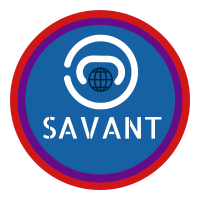Dr. Dave’s academic world tour continues with new presentation at the University of Zurich
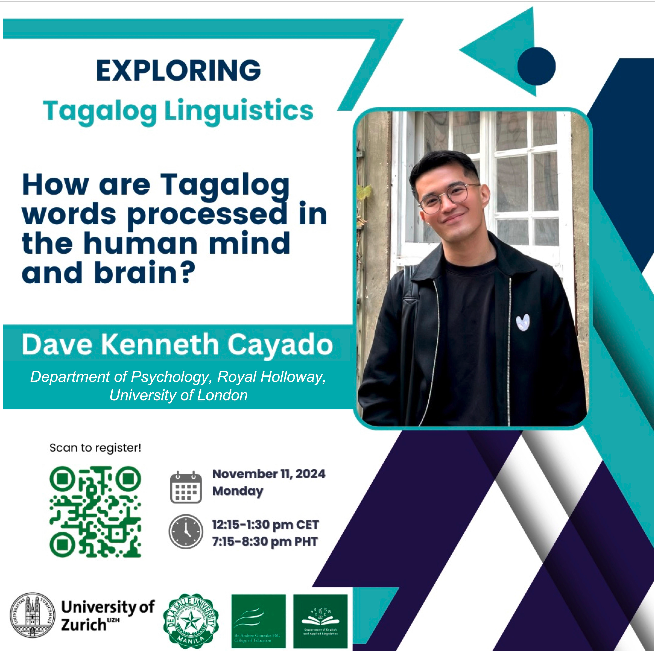
New SAVANT paper published!
Dave’s new paper, MEG evidence for left temporal and orbitofrontal involvement in breaking down inflected words and putting the pieces back together, has been published in Cortex! The paper was co-authored with Samantha Wray, Dustin Alfonso Chacón, Marco Chia-Ho Lai, Suhail Matar, and Linnaea Stockall.
Check it out here.
Dr Dave invited for a guest lecture!
Dave Kenneth Tayao Caydo was invited to present their work on Tagalog morphology. The talk titled “What can morphological processing theories learn from Tagalog morphology?” was presented at the International Meeting on Quantifying Semantic-Orthographic Regularities Across Languages (QuaSemO 2024), Munich, Germany.
SAVANT go to AMLaP!
Dave Kenneth Tayao Caydo, Samantha Wray, and Swarnendu Moitra presented their work in Edinburgh at Architectures and Mechamisms for Language Procession. Check out their posters and presentations here!
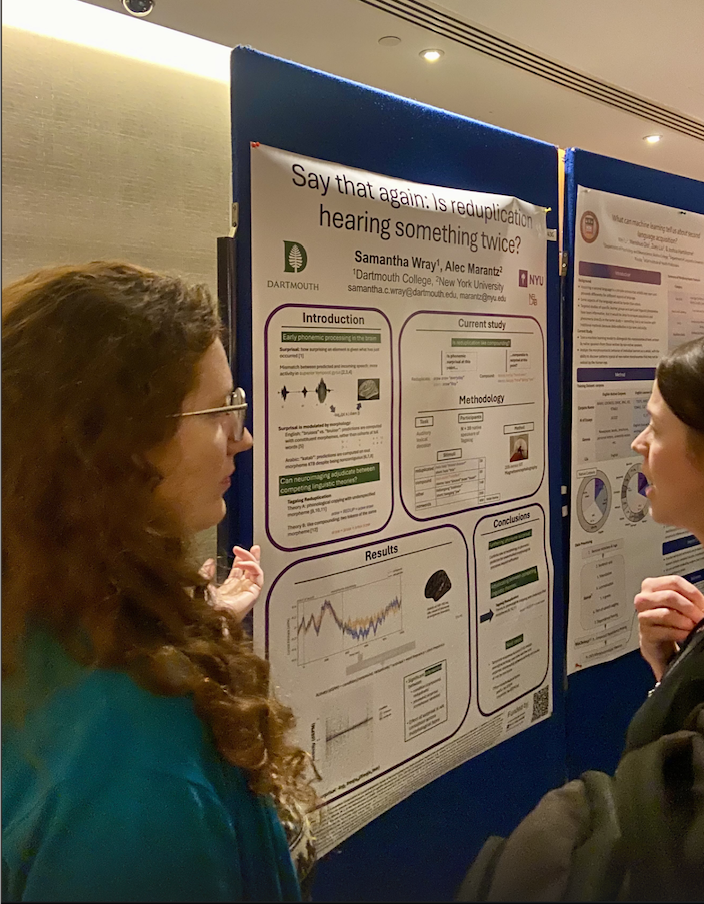


SAVANT Team present work at WoProc!
The SAVANT team presented at the International Word Processing Conference in Belgrade, Serbia. Check out all their presentations here!
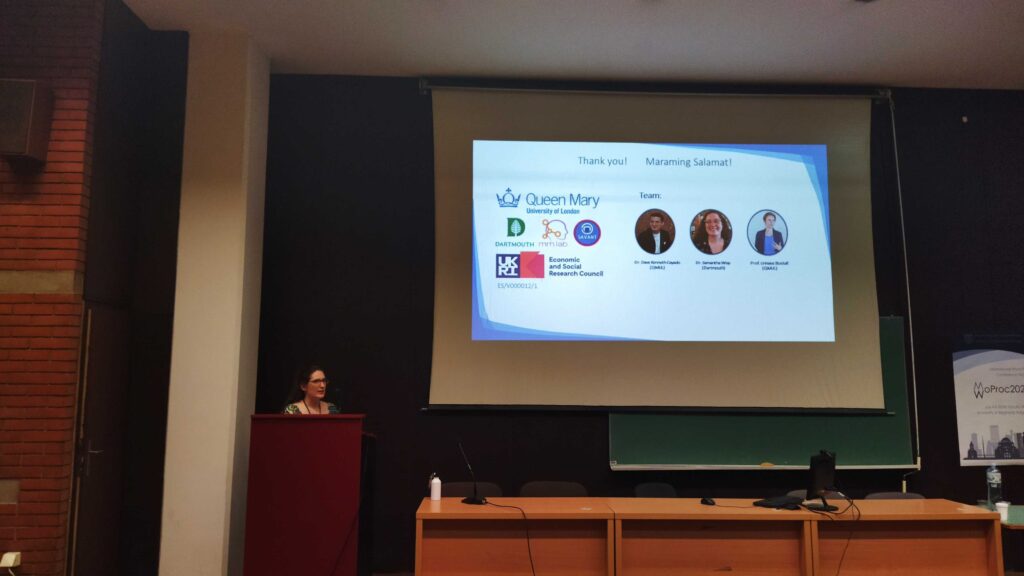
Exciting News: SAVANT Project Extension Granted by ESRC!
We are thrilled to announce that the ESRC has granted us a one-year extension for our SAVANT project! This additional year will allow us to achieve several significant milestones and continue our impactful work.
What This Means for SAVANT
1. Expanding Our Research: We will extend our MEG results to EEG for Tagalog, Bangla, Slovenian, and Bosnian/Serbian/Croatian languages, enhancing the scope and depth of our experiments.
2. LexiVault Expansion: Additional languages will be implemented into our LexiVault lexical characteristics database, broadening its utility and accessibility for linguistic research. Explore LexiVault here: LexiVault Database.
3. Community Engagement: We will run an additional year of our educational programs with local secondary schools in east London and Ljubljana!
Stay tuned for more updates on our progress and achievements!
Summer School 2024!
On Wednesday, 12 June 2024, the SAVANT team and the Linguistics Department at Queen Mary University of London hosted an exciting Experimental Linguistics Taster Day for A-level English Language students from Leyton Sixth Form College. This event provided an in-depth look at how linguists study language and its fascinating intersection with psychology and sociology.
SAVANT Project Showcased at Serbian Cultural Center Science Fair
In May, our team participated in a Science Fair organized by the Serbian Cultural Center in Ljubljana. The event featured a 20-minute presentation led by Bojana Ristić on the EEG and the SAVANT project, delivered in BCS (Bosnian-Croatian-Serbian). Our presentation included an introduction to neurolinguistics, an explanation of the EEG technique, a brief overview of the Savant project, and a quick demonstration. The session sparked interest and curiosity, and the audience was very engaged, with members asking about the “bilingual brain?” It was particularly rewarding to hear comments like, “My kid didn’t know science could be fun,” highlighting the engaging nature of the event.
For more details, check out the Facebook event.
Beta version of LexiVault, a repository for psycholinguistic lexicons of lesser-studied languages, is out!
Samantha Wray to present at LREC-COLING 2024!
Samantha and her collaborators Hind Hind Saddiki and Daisy Li will be presenting at Lingotto Conference Centre – Torino (Italia). The presentation is on LexiVault: A repository for psycholinguistic lexicons of lesser-studied languages! For more information, check out the program here.
Dave invited to speak at a conference (again)!
Dave got invited as a keynote speaker at the International Meeting on Quantifying Semantic-Orthographic Regularities Across Languages
(QuaSemO 2024) conference in Munich, Germany.
New paper alert!
Swarnendu Moitra, Dustin A. Chacón, and Linnaea Stockall just published a new paper titled “How long is long? Word length effects in reading correspond to minimal graphemic units: An MEG study in Bangla“
Dave to present at the University of Hong Kong!
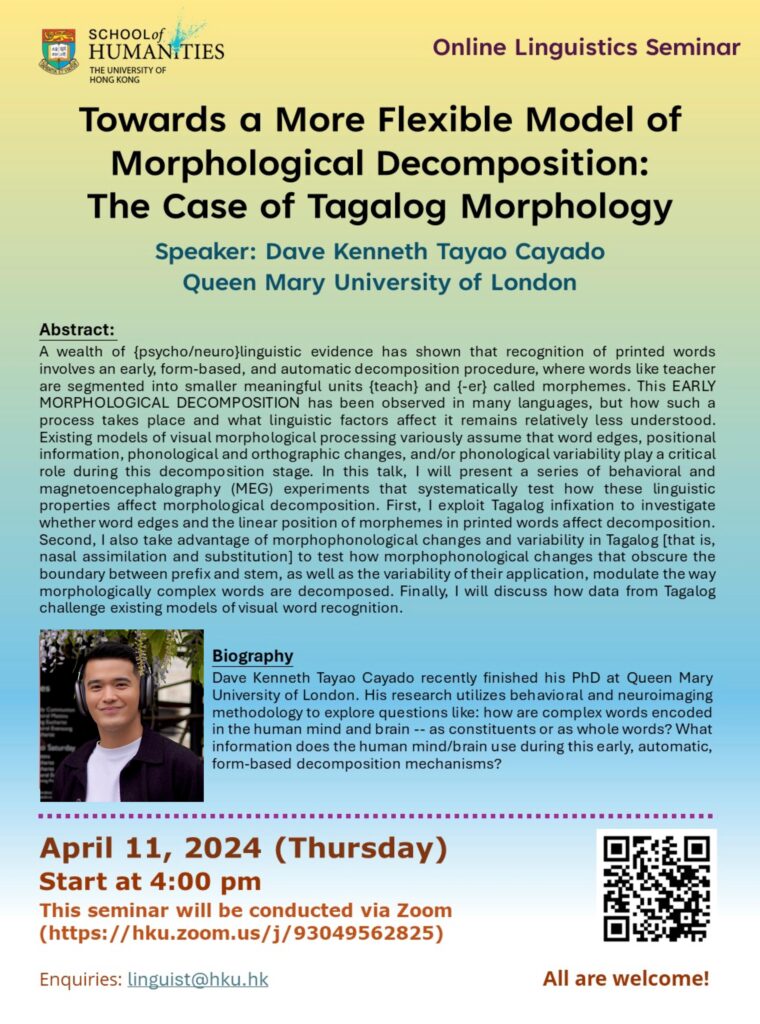
Samantha Wray gives a presentation titled “Getting to the root of morphological processing: Arabic as a window to the syntactic and phonological interfaces”
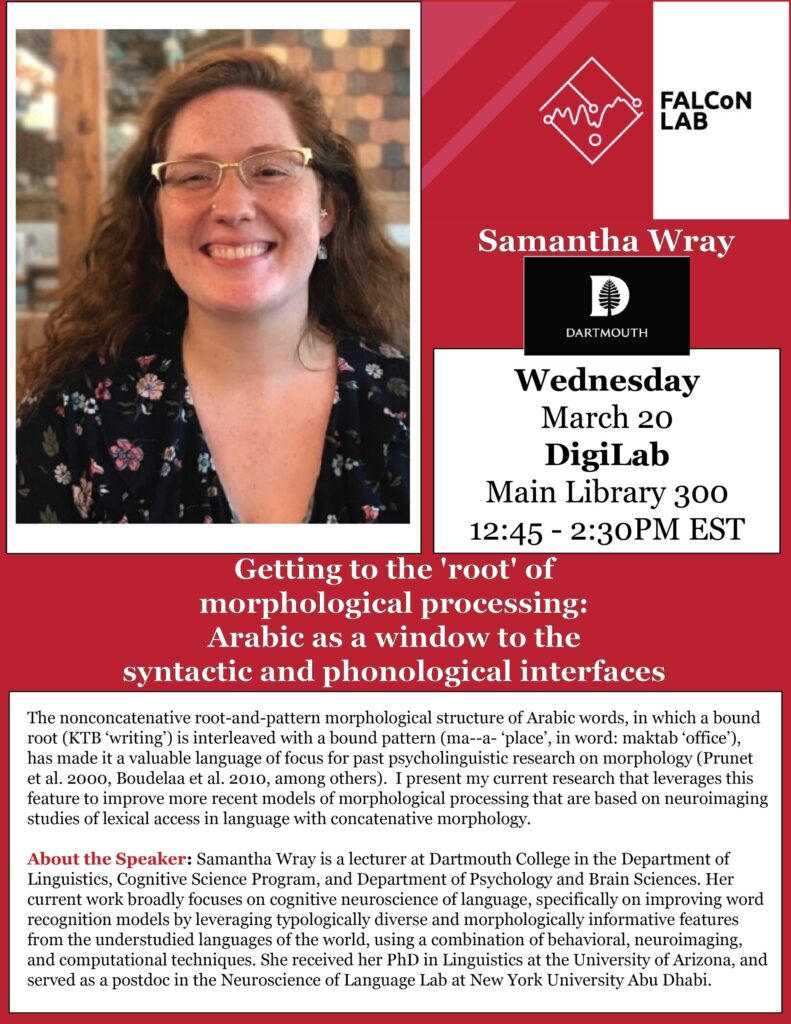
Dave Kenneth Tayao Cayado hosts a symposium on the impact of Tagalog on Psycholinguistics and formal linguistics!
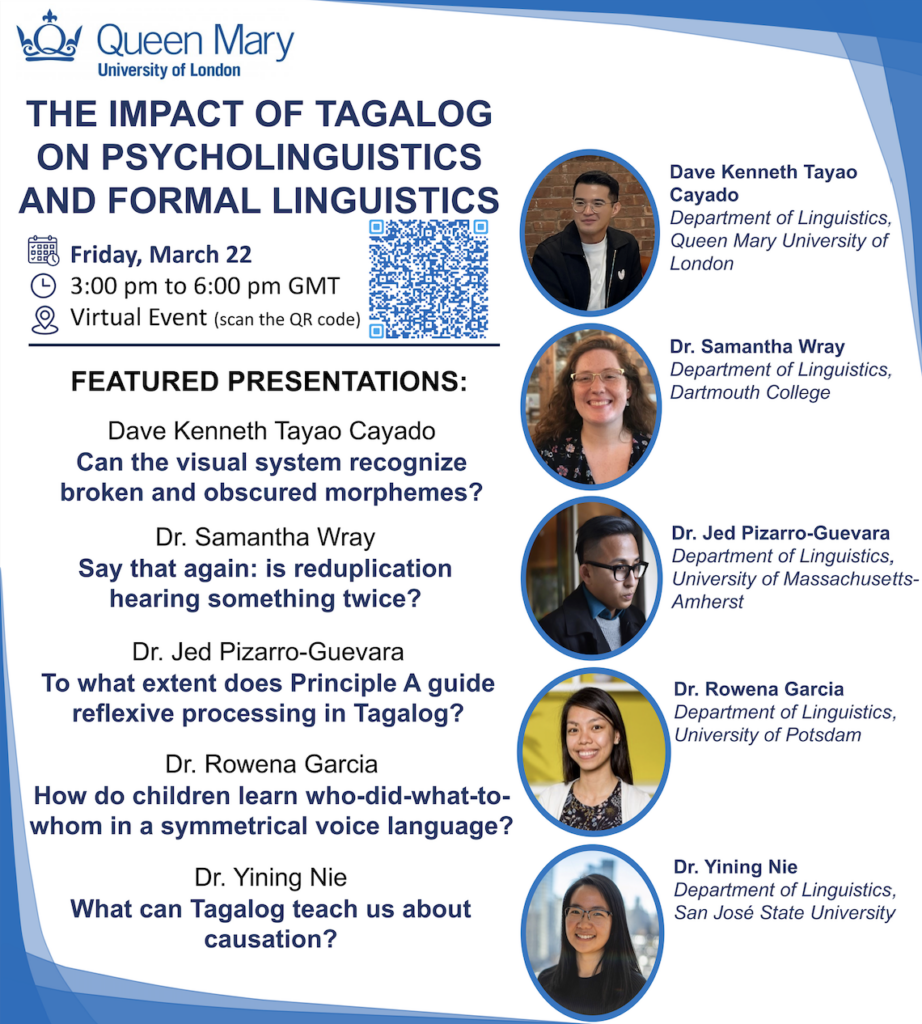
As a part of Dave’s PhD viva voce examination, he invited scholars around the world whose work on Tagalog has significantly contributed to our current knowledge of psycholinguistics and formal linguistics. The symposium will be chaired by Dr. Adam Chong and featured speakers include Dr. Samantha Wray from Dartmouth College, Dr. Jed Pizarro-Guevara from the University of Massachusetts-Amherst, Dr. Rowena Garcia from the University of Potsdam, and Dr. Yining Nie from San José State University.
Stay tuned for more details on Dave’s event here.
Samantha Wray presents at Western’s Department of Linguistics!
The talk is titled, “illuminating language processing by leveraging linguistic diversity” and explores how a wealth of research has sought to explain how our minds and brains perform common (but nonetheless computationally complex) tasks, such as parsing a word into its constituent morphemes. However, the seminal work behind these major models is often informed by only a handful of language families with a limited array of linguistic features, leaving the particulars of how language is processed incomplete
Bangla team present work at ACCS-X 2023.
Swarnendu Moitra headed to India to present the Annual Conference of Cognitive Science – X! Swarnendu presented a poster titled “Neural responses sensitive to ‘letter-specific recognition’ in left and right occipitotemporal regions: bilateral ‘Visual Word Form Area’ for Indic languages?” Check out the poster here.
SAVANT Team present work at X-PPL!
SAVANT’s isiXhosa, South Slavic, and Spanish teams present their work at X-PPL 2023 (Crosslinguistic Perspectives on Processing and Learning). They explored the complexities of isiXhosa word formation using an auditory lexical decision task, as well as processing semantic affix attachment rule violations in South Slavic and Colombian Spanish. Check out their presentations here.
SAVANT GO TO SNL!
Our team members recently presented their work at the Society for the Neurobiology of Language (SNL) conference in Marseille, France. The team presented their research and findings on morphological processing in a cross-linguistic context. Their work showcased the distinctive stages involved, including decomposition, syntactic category checks, and semantic compatibility evaluation in languages such as Tagalog, Arabic, and Bangla. Notably, these studies uncovered intriguing variations in activation patterns, highlighting the intricate interplay between language structure and meaning.

NEW PAPER ALERT: How long is long? Word length effects in reading correspond to minimal graphemic units: An MEG study in Bangla
The preprint for Swarnendu Moitra, Dustin Alfonso Chacón, and Linnaea Stockall’s new paper is available now. Our findings reveal a strong correlation between MEG signals and word length within the anterior left fusiform gyrus, occurring approximately at 130 milliseconds. This correlation is especially pronounced when measured using minimal graphemic units. Our findings suggest that minimal graphemic units could serve as a suitable metric for measuring word length in non-alphabetic orthographies such as Bangla.
You can check out the preprint on BioRxiv here.
South Slavic Team participate in this year’s Science Festival (Festival Znanosti) in Nova Gorica, Slovenia
Christina and Rok talked to the general public about the neuroscience of language and our work in the project SAVANT. The event was attended by 20-25 people and it also included a demonstration of how EEG works by using the project’s portable EEG. We thank E-hiša (House of Experiments) and X-Centre for the excellent organization and their hospitality!
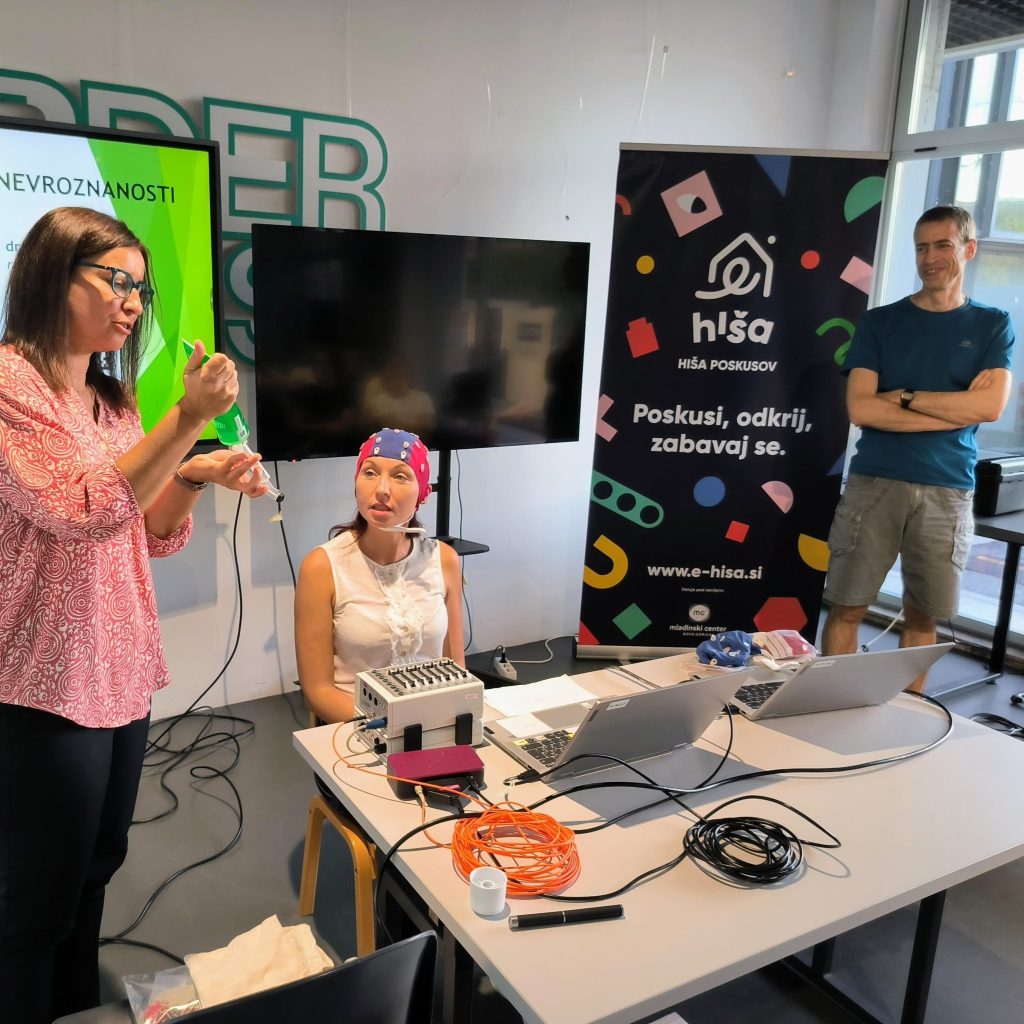
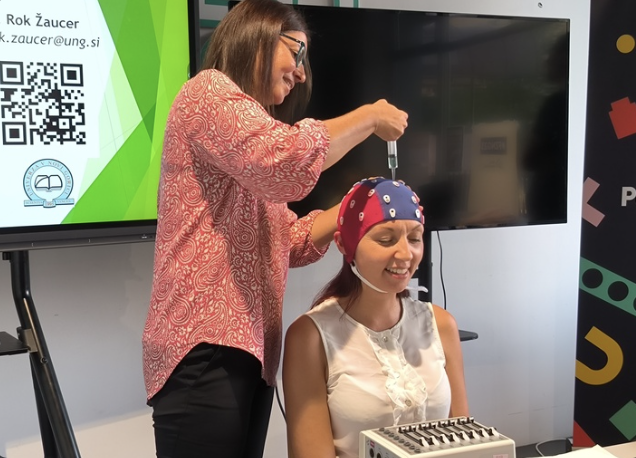
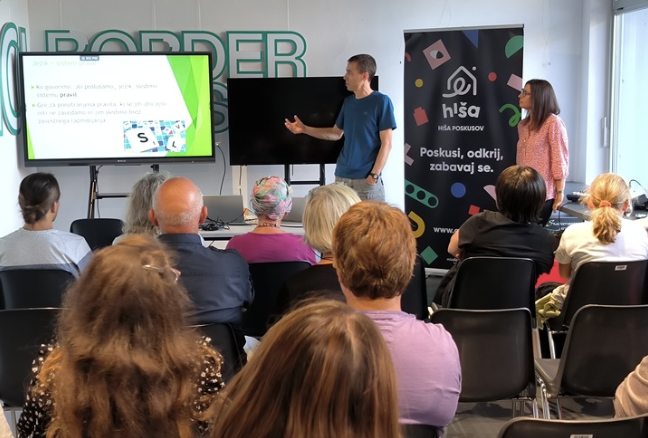
SAVANT Team at AMLaP 23
Dave Cayado and Samantha Wray have recently presented their work at AMLaP 23 in San Sebastian, Spain. To check out their posters click here!
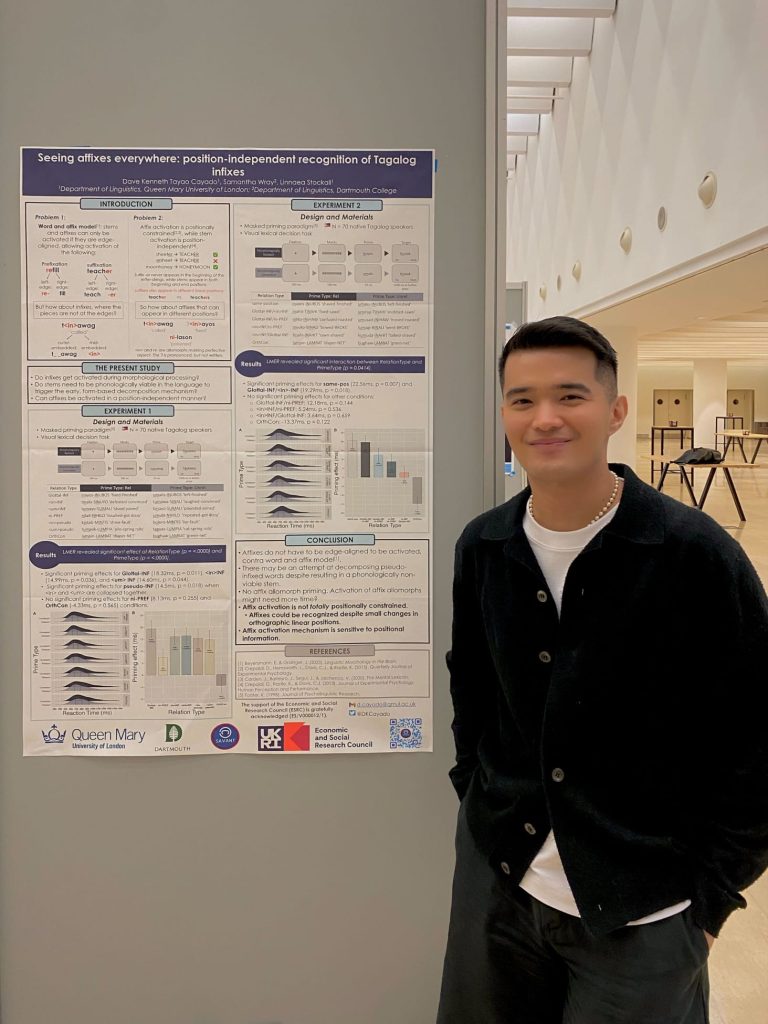
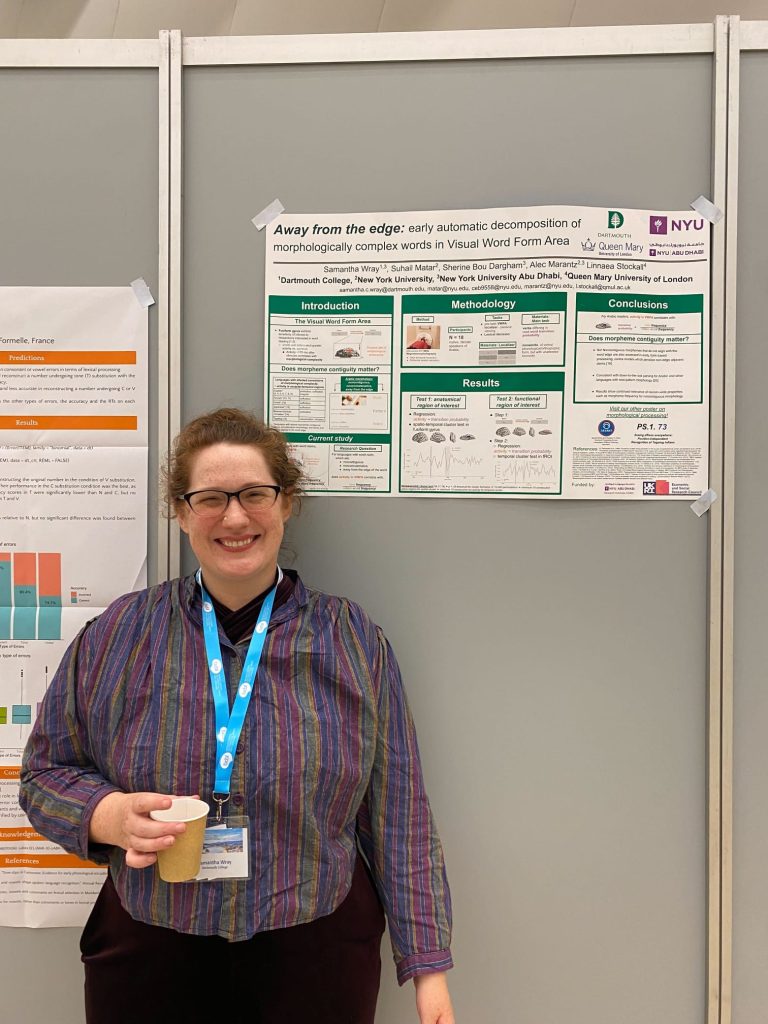
NEW PAPER: Does linear position matter for morphological processing? Evidence from a Tagalog masked priming experiment
Excited to announce Dave Kenneth Tayao Cayado, Samantha Wray, and Linnaea Stockall’s new paper published in Language, Cognition and Neuroscience.
The main finding reveals that Tagalog infixed, prefixed, and suffixed words exhibited robust masked priming effects, suggesting that these words are segmented into morphological units during early visual word recognition. This challenges the proposal that stem activation relies on edge-alignment. The study’s implications indicate that the orthographic matching system in Tagalog is flexible enough to accommodate non-contiguous letter-strings in infixed words and that successful stem activation does not require edge-alignment. This groundbreaking research expands our understanding of morphological processing in Tagalog, contributing to the field of psycholinguistics and advancing our knowledge of language processing in diverse linguistic systems.
Check out the paper here.
INVITED TALK: Dave Kenneth Tayao Cayado recently presented their work at Royal Holloway
Dave was recently invited to give a talk titled “What can morphological processing theories learn from Tagalog morphology?” at the Department of Psychology, Royal Holloway, University of London, Egham, UK.
New languages added to the SAVANT Project!
We are thrilled to announce the addition of three fascinating languages to our project: isiXhosa, Azeri, and Latin American Spanish! Our team is excited to further our research on these understudied languages.
SAVANT team presented their research at a public event on Friday, May 20th in Ljubljana
The event was attended by Her Excellency Mrs. Tiffany Sadler, U.K. Ambassador to Slovenia, and Her Excellency Mrs. Namrata Kumar, Indian Ambassador to Slovenia, who each gave a brief address to the audience about the importance of international scientific collaboration, and the value of linguistic diversity.
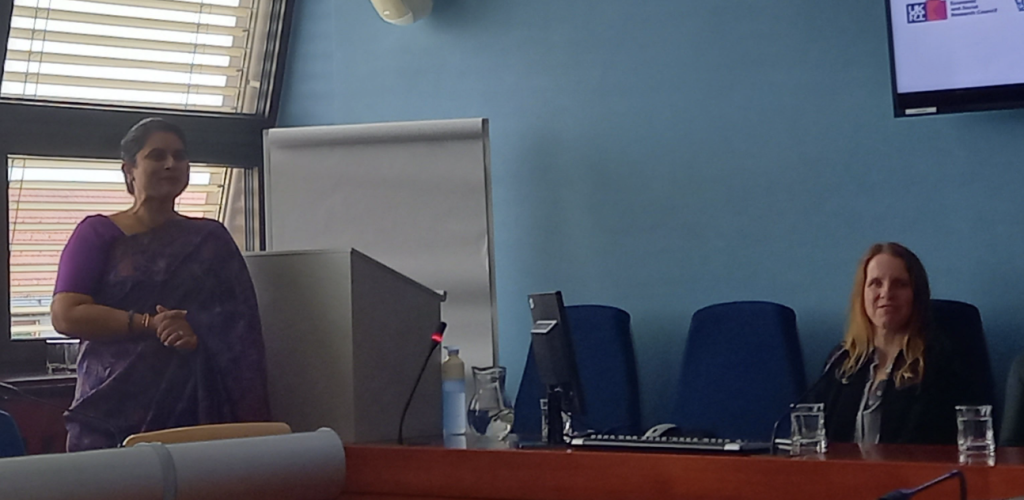


Summer School is back for 2023!
We are happy to announce that our annual Neurolinguistics Summer School is back! This year the Summer School will be run with undergraduate students from Queen Mary University of London.
For more information checkout our Summer School page.
New Team Presentations at Society for the Neurobiology of Language (SNL)
Our team members recently presented their work at the Society for the Neurobiology of Language (SNL) conference in Philadelphia, United States of America. They presented research on various topics related to language processing.
Swarnendu Moitra, Dustin Alfonso Chacón, and Linnaea Stockall presented a poster titled “How long is long? – M100 response in Bangla tracks number of phonemes not graphemes or glyphs.”
Samantha Wray, Suhail Matar, Alec Marantz, and Linnaea Stockall presented a poster titled “Localizing early visual word processing for Arabic script.” Their research explores the localization of early visual word processing in Arabic script.
Dave Cayado, Samantha Wray, and Linnaea Stockall also presented a poster titled “Localising and Investigating Morphological Decomposition in Tagalog: an MEG study.”
New Team Presentations at the 9th Annual Conference of Cognitive Science (ACCS9)
Swarnendu Moitra presented his work at the 9th Annual Conference of Cognitive Science (ACCS9) held in New Delhi, India, in December 2022. The poster presentation and talk was titled “How long is long? An MEG study of M100 response in tracking word length in Bangla/Bengali”.
New Team Presentations at Architectures and Mechanisms for Language Processing (AMLaP)
Members of our team recently presented their work at the Architectures and Mechanisms for Language Processing (AMLaP) conference in York, United Kingdom. In their presentations, they showcased their research on various languages, including Tagalog and Slovenian.
Dave Cayado, Samantha Wray, and Linnaea Stockall gave two presentations: “Breaking down: Tagalog infixed, prefixed, and suffixed words are automatically decomposed in visual word processing” and “Morphological Recomposition in Tagalog: support for a two-stage model.“
Swarnendu Moitra, Dustin Alfonso Chacón, and Linnaea Stockall presented a poster titled “Morphological recomposition and the concrete/abstract distinction in Bangla.“
Finally, Bojana Ristić, Karin Kavčič, Rok Žaucer, Linnaea Stockall, and Christina Manouilidou gave a presentation titled “Category vs. semantic violations in prefix attachment in Slovenian.“
New Paper: Early Form-Based Morphological Decomposition in Tagalog: MEG Evidence from Reduplication, Infixation, and Circumfixation
This groundbreaking study is the first ever to investigate how the morphological processes of Reduplication, Infixation and Circumfixation are parsed using Magnetoencephalography to measure brain responses. The overwhelming majority of research on morphological processing has been restricted to Indo-European languages, in which Reduplication, Infixation and Circumfixation are not present. But these are all perfectly normal and common ways of building complex words in Tagalog and many related Austronesian languages. In this experiment, we have discovered that reduplicated prefixes, infixes, and circumfixes all trigger the same early, form based morphological decomposition mechanisms previously only observed for prefixes and suffixes in languages like English and Greek. MMMRG PhD student, and Tagalog native speaker, Dave Kenneth Cayado is building on these initial results in his PhD research, and we are conducting a follow up study to investigate morphological re-composition as part of our SAVANT project.
